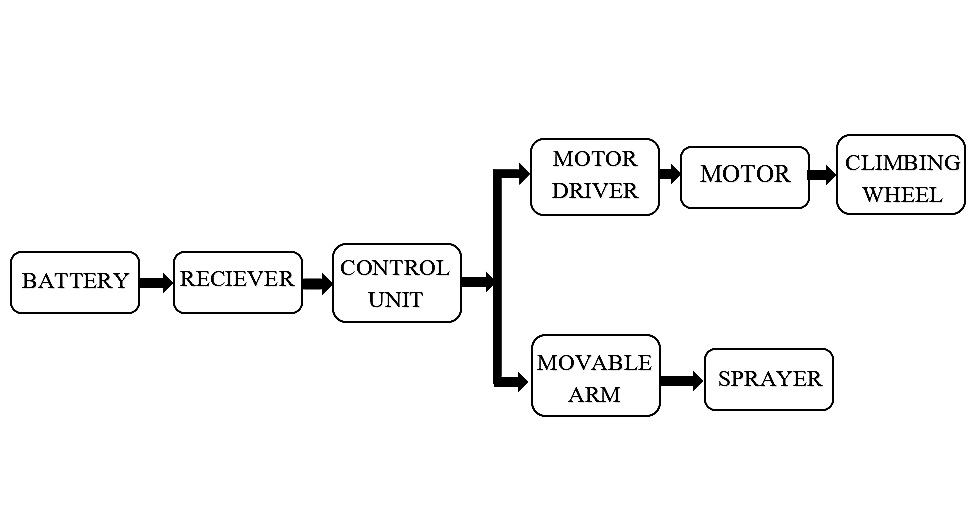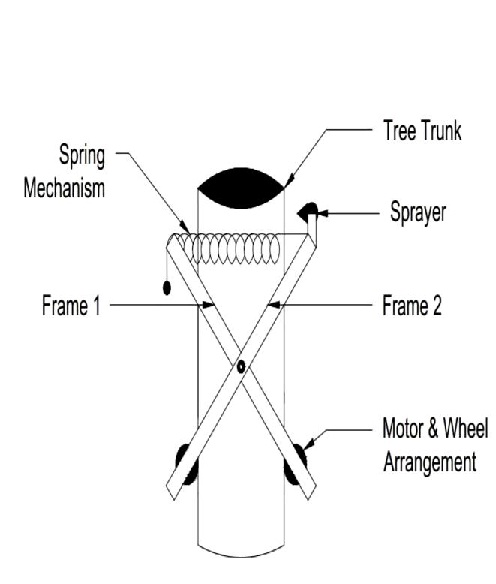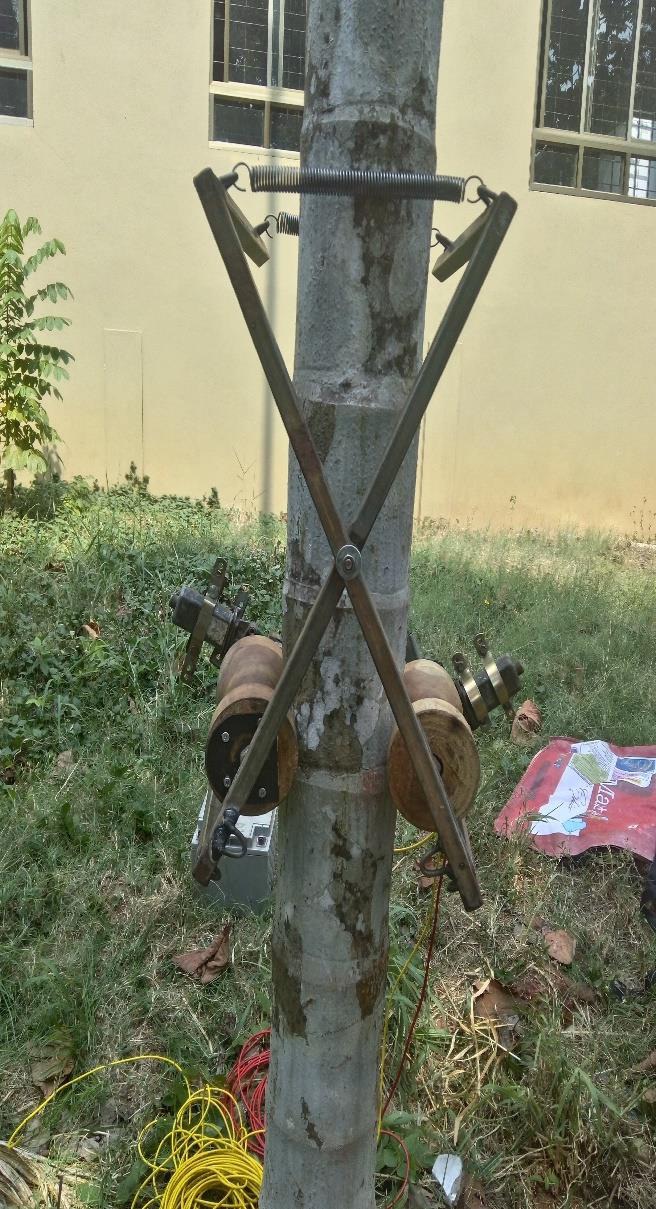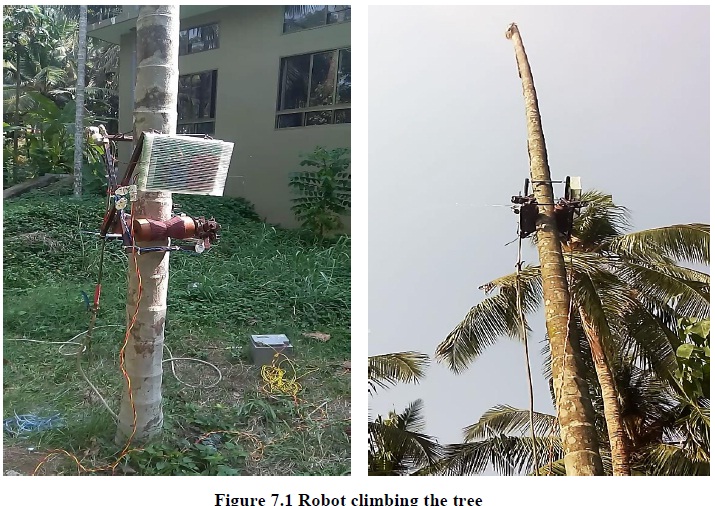





Published on Nov 30, 2023
This project was suggested to us by Krishi Vigyan Kendra, Brahmavar based on their research. The objective of this project is to design and develop a robot which can climb the Arecanut tree and spray pesticide, thereby reducing time and labour required for the same job. In recent years, labour scarcity has emerged as one of the foremost challenges in farming. One of the crop that has been most affected by this is the arecanut. It is mandatory to climb the tree a minimum of five times a year for a successful harvest i.e., twice for the preventive spray against fungal disease, and thrice to harvest the arecanut. Only skilled labourers can carry out this task. The robot consists of an ‘X’ frame. At the bottom of the robot two rollers are placed which are conical in shape and are connected to two DC motors. These motors are operated by a remote control to move up and down the tree. The model is placed around the tree and springs are used to attach it firmly to the tree. Two nozzles are placed on either side at the top of the machine with motor arrangement so that it can rotate at a 360-degree angle. Electric pumps are used to lift the pesticide towards the nozzle and spray it to the arecanut.
Arduino Uno is used for programming the motors to rotate in clockwise and anticlockwise direction. The robot has been tested for its climbability and it is portable. This robot reduces the time and also dependence on labour. The sprayer sprays pesticide to the adjacent trees with good level of accuracy. The flow of pesticide is remotely controlled. The user interface is easy.
The future improvements for this project are as follows: -
I. Adding a nut cutter.
II. Lowering the weight.
III. Computer vision can be added to identify the healthy arecanut.
IV. The process of spraying pesticide can also be made fully automatic using image processing sensor.
V. Wheels with better frictional co-efficient can be designed.
Areca nut (Areca catechu) a tropical crop, is popularly known as betel nut in India. It is one of the most important commercial crop in South-East Asia in general and India in particular. As per FAO statistics for 2013, India is the largest producer of areca nut accounting for 49.74% of the world output. In India, as of 2013-2014 Karnataka is the largest producer of Areca nut in India resulting in 62.69 percent of the country’s output. The plant grows in well drained, deep clay loamy soil; laterite, red loam and alluvial soils are considered most suitable. Areca nut farming, to achieve good yield, needs large application of organic manures and chemical fertilizers. The gestation period for the areca nut tree to yield fruits varies from four to eight years. Its life span is up to 60 years and in some cases even 100 years. The Arecanut tree grows to a height of 60 feet to 70 feet and measures 15 cm in diameter.
In recent years, non- availability of labors has emerged as one of the biggest challenges in farming. One crop that has been most affected by this is the areca nut. Arecanut trees attain a height of about 60-70 feet. It is mandatory to climb the trees a minimum of five times a year for a successful harvest - twice for the preventive spray against fungal disease, and thrice to harvest the areca nut. Koleroga is another such disease prevalent in high rainfall regions. This disease assumes intensity during south- west monsoon causing heavy damage to the crop. Bud- rot, food- rot, stem breaking, inflorescence die- back, stem bleeding are other diseases which affect areca yield and cause damage in varying degrees. Yellow leaf disease has been causing much damage to areca nut.
This disease is categorized by the yellowing of leaves of leaves. As a result, there is reduction in the size of leaves and nuts, tapering of the stem and mature nutfall occurs. It is estimated that about 35- 40 % of areca plantation in Kerala has been affected by this disease. In addition to the diseases mentioned above areca nut are also affected by many pests and insects. Therefore, in order to prevent the above-mentioned problems pesticides are sprayed frequently to the Arecanut. This also solves labor problem. Also, it reduces the wastage of pesticides. The farmers are exposed to the toxicity of pesticides and suffer from pesticide poisoning which range from skin irritation to coma or even death.
In olden days’ farmers used to manually climb the trees till the top and spray pesticide to the areca nut bush. After spraying pesticides to the Arecanut they would jump to the adjacent tree. This is a very risky job as the tree climbers could slip and fall down and meet with serious injuries. Moreover, the tree climbers also do not have any kind of medical insurance, this only worsens the problem. In modern days’ farmers use mechanical pump or electric pump to spray pesticide to the Arecanut. First the farmer has to climb the tree halfway and then use a nozzle to spray pesticide to the Arecanut. This method is less risky than the previous one. But this method consumes a lot of time and lot of pesticide is wasted as all the pesticide does not reach the Arecanut.

A 9V battery is used to supply power to the controller.
The controller is Arduino Uno ATmega328PU processor.
It consists of push buttons to control the movement of robot and sprayer.
A 433 MHz transmitter sends the signal to the receiver through an antenna.

The battery used is 12V 42 AH which supplies power to the control circuit and to the motors.
It receives the signals from the transmitter circuit.
It consists of Arduino Uno ATmega328PU which is used to control the motors for climbing the trees and to move the stepper motor attached to the nozzle for spraying. Motor
It consists of ULN2803 IC and 12 V relays connected in H-Bridge fashion to drive the DC motors in clockwise and anti-clockwise direction.
The Movable arm consists of two 12V 100 RPM DC motors attached with the nozzle to spray pesticide to the Arecanut.
A 12V High Torque DC motor with gears which is attached to the rollers and used to climb the tree.
The sprayer sprays the pesticide in fine droplets with high speed at the Arecanut branch.
The wheels are conical in shape and are in contact with the tree. For better grip, it is covered with rubber.
The robot consists of an ‘X’ frame. At bottom of the robot two conical rollers are placed which is connected to two motors. The material used is stainless steel and the robot weighs 8 Kgs.


The Arecanut tree climber and pesticide sprayer works on the basic principle of friction. The robot consists of an ‘X’ frame with two rollers at the bottom. One face of the frame is open and is placed around the tree. Springs are used to grip the robot to the tree as the size of the tree varies. The robot is supplied power through a 12V, 42Ah battery. A remote is used to control the motor. When the power is switched ON, the motor rotates the rollers. Due to the friction between the rollers and tree, the robot ascends along the length of the tree without causing any damage to the tree. When the robot reaches the required height, it stays there without slipping. The tension of the spring retains the robot at the required height. Once the robot reaches the required height the motors are stopped by the remote control. The movable arm is capable of rotating at an angle of 360 degrees. The nozzle mounted on the movable arm sprays pesticide to the arecanut branch of the tree which it has climbed and also to the adjacent trees. A solenoid valve is used to remotely stop or resume the flow of pesticide. After spraying pesticide is completed the robot descends down the by rotating the rollers in opposite direction. After the robot reaches the ground, it is removed from that tree and attached to another tree for spraying.
This is the most suitable robot for spraying pesticide to the arecanut. The robot is attached and removed from the tree easily. After the robot has been attached, springs are used to fix the robot firmly to the tree. The robot operates on 12V 42 Ah battery and climbs the required height very quickly. Once the robot reaches the required height it stays there without slipping. The sprayer covers a wide angle and sprays pesticide to the arecanut bunch on the nearby tree up to a radius of 15 to 20 metres. After spraying is done it smoothly descends the tree. This robot reduces the time and also dependence on labour. A solenoid valve is used to stop or resume the flow of pesticide. All the above functions of the robot are controlled by remote.

1. This project aims at replacing conventional methods of spraying, which are dependent on
labourers, with a more cost effective and environment friendly system, dependent on
electricity.
2. The robot is compact.
3. The robot is user friendly and a person with little technical knowledge can assemble it in an ordinary workshop.
4. It reduces time and dependence on labour.
5. This is the most suitable machine without man climbing on the tree.
6. This robot is attached and removed easily to the tree.
7. This robot is operated from a safe distance without exposing the farmer to the harmful effects of pesticide.
The future improvements for this project is as follows: -
I. Adding a nut cutter.
II. Lowering the weight.
III. Computer vision can be added to identify the healthy arecanut.
IV. The process of spraying pesticide can also be made fully automatic using image processing sensor.
V. Wheels with better frictional co-efficient can be designed.
I. Arecanut tree climber and pesticide sprayer is a unique model which serves as a great help and boon to arecanut farmers.
II. The arecanut tree climber and pesticide sprayer has been tested on an arecanut tree with satisfactory results.
III. The innovative component of the developed robot is the ‘X’ frame with two conical rollers at the bottom and the ability of the sprayer to spray pesticide with a good level of accuracy without wasting pesticide solution.
IV. Arduino Uno is used for programming which is a cost-effective device.
V. A farmer with little or no technical knowledge can easily operate the robot from the ground with a remote control.
VI. The project concludes that the arecanut tree climber and pesticide sprayer is a safe, reliable, efficient robot and reduces the risk involved in manual climbing and spraying to a great extent.
[1] Design and Fabrication of Arecanut Tree Climbing and Spraying Machine, Mr. M Tony, St. Joseph Engineering College, Vamanjoor.
[2] Remote Controlled Tree Climbing Machine for Arecanut Tree, Mr. Chandrakanth Shenoy K, Canara Engineering College, Bantwal
[3] Arecanut Tree Climber, Mr. Akshay Kumar
[4] https://en.wikipedia.org/wiki/Areca_nut_production_in_India.
[5] https://en.wikipedia.org/wiki/Areca_nut.